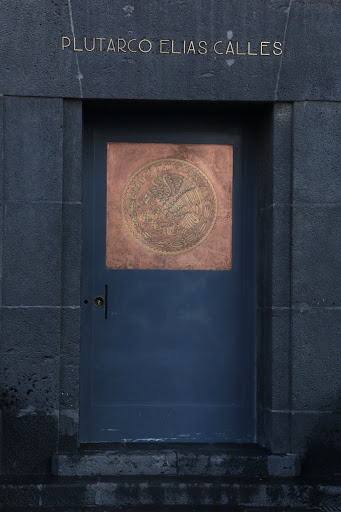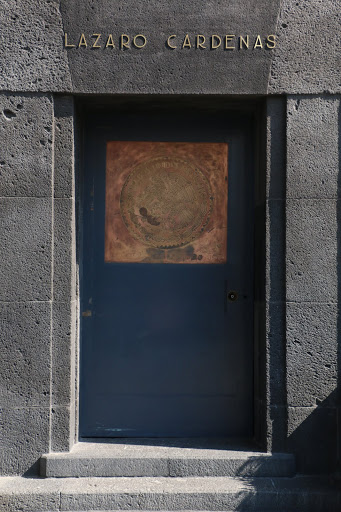 |
| Monument to the Revolution |
End of Zapata
Returning after a few months, Zapata mounted guerrilla warfare throughout the state and into the Federal District, blowing up trains between Cuernavaca and the capital. Through low-scale attacks on González's positions, by the end of 1916 Zapata had driven González out of Morelos.
In April of 1919, Zapata was drawn into a trap. Believing that Colonel Jesús Guajardo was going to defect from González, he went to meet with him. He was shot to death.
End of Carranza
End of Carranza
In the 1920 presidential election, Carranza'a natural successor was Álvaro Obregón. But Obregón had supported the radical articles of the new Constitution. After Carranza was elected President, he retired to Sonora. In 1919, Carranza endorsed Ignacio Bonillas, an obscure diplomat, for the presidency. Obregón announced his independent candidacy and began campaigning across the country where he was seen as a hero of the Revolution. Carranza accused him of a plot to overthrow the government. Obregón went into hiding in the southern state of Gurerrero, where a friend was governor.
Obregón allied himself with other Sonoran generals, Plutarco Elías Calles and Adolfo de la Huerta. On April 23, 1920, they issued the Plan of Agua Prieta, which repudiated the Carranza government and called for Carranza's overthrow. Much of the Mexican Army went over to Obregón and his allies.
Obregón brought these Army Forces to Mexico City and drove Carranza out. Carranza set out toward Veracruz but on May 21, 1920, he was killed while sleeping in Tlaxcalantongo in the mountains of Puebla. De la Huerta became Provisional President until elections were held, and Obregón became President on December 1.
End of Pancho Villa
After his defeat at Agua Prieta and his raid in Columbus, New Mexico, Villa continued guerrilla actions with a small group of men. His last military action was a raid in 1919 against Ciudad Juárez. He then conducted a small attack on Ascención, Durango, which failed. At this point Villa offered to cease fighting if it were made worth his while.
Obregón's coup de'etat against Carranza opened a door for Villa to negotiate a peace settlement and retire. On July 22, 1920, Villa sent a telegram to Mexico's Interim President, Adolfo de la Huerta, stating that he recognized Huerta's Presidency and requested amnesty. Six days later, De la Huerta met with Villa and successfully negotiated a peace settlement.
In exchange for his retirement from hostilities, Villa was granted a 25,000 acre hacienda in Canutillo, just outside Hidalgo del Parral, Chihuahua. This was in addition to the Quinta Luz estate that he owned with his wife, María Luz Corral de Villa, in Chihuahua, Chihuahua. The last remaining 200 guerrillas and veterans of Villa's militia who remained loyal to him were also allowed to reside with him at his new hacienda, and the Mexican government granted them a pension totalling 500,000 gold pesos. The 50 guerrillas remaining in Villa's small cavalry would be allowed to serve as Villa's personal bodyguards.
Obregón could not run again for the Presidency, so there was political uncertainty about the Presidential succession. Obregón favored General Plutarco Elías Calles, who had defeated Villa at Agua Prieta, for the Presidency. Villa's agreement in 1920 to withdraw from fighting and retire to a hacienda had left open the possibility that he might enter politics, which would complicate the political situation for Obregón and Calles.
End of Obregón
Obregón was not eligible to run in the 1924 Election, so in 1923 he endorsed Plutarco Elías Calles for President. Finance Minister Adolfo de la Huerta, who had joined Obregón in the rebellion against Carranza and had served as Interim President in 1920, believed that he deserved to be the next President, so he organized an uprising against Obregón. Over half the Army joined De la Huerta, with many of Obregón's former comrades in arms now turning on him. Rebel forces massed in Veracruz (East Coast) and Jalisco (West Coast).
In a decisive battle at Ocotlán, Jalisco, Obregón's Federal Forces crushed the rebels. The U.S. supplied Obregón with arms and sent 17 U.S. planes that bombed rebels. Obregón hunted down many of his former friends and had them executed. After the rebellion was crushed, Calles was elected President of Mexico.
Rise of Calles
Plutarco Elías Calles led elements of the Constitutional Army in Sonora, together with Álvaro Obregón, and defeated Pancho Villa in the Battle of Agua Prieta in 1915. He then became governor of Sonora. In 1919, Venustiano Carranza appointed Calles Secretary of Commerce, Industry and Labor. In 1920, Calles aligned himself with Álvaro Obregón in the overthrow of Carranza. Obregón named him head of the Secretariat of Government, the agency that esssentially ran the government. In 1924, Obregón tapped Calles to be his successor.
Calles campaigned on a populist agenda of implementing the Revolution's land and labor reforms embodied in the 1917 Constitution. Once in office, Calles initially supported land reforms and promoted ejidos, communal lands for the indigenous, but nonetheless, no large tracts of land were redistributed under his Presidency.
Calles was staunchly anticlerical and during his term as President, he moved to enforce the anticlerical articles of the 1917 Constitution. On June 14, 1926, President Calles enacted anticlerical legislation known formally as The Law Reforming the Penal Code. Unofficially, it was known as the Calles Law, which outlawed religious orders, deprived the Church of property rights and the clergy of civil liberties, including the right to vote. Enforcement of these laws led to the Cristero War (1926–29).
In the summer of 1926, Mexicans in strongly Catholic areas, especially the western states of Jalisco, Colima and Michoacán, and the central states of Zacatecas and Guanajuato, began to rebel. Then, in January 1927, a war cry went up, "¡Viva Cristo Rey!" "Long live Christ the King". Almost 100,000 people on both sides died in the war. Approximately five hundred Cristero leaders and 5,000 other Cristeros were executed. At least 4,000 priests were killed or expelled. Prior to the rebellion, there were 4,500 priests in Mexico; in 1934, there were only 334. By 1935, seventeen states had no priests at all.
Calles campaigned on a populist agenda of implementing the Revolution's land and labor reforms embodied in the 1917 Constitution. Once in office, Calles initially supported land reforms and promoted ejidos, communal lands for the indigenous, but nonetheless, no large tracts of land were redistributed under his Presidency.
Calles was staunchly anticlerical and during his term as President, he moved to enforce the anticlerical articles of the 1917 Constitution. On June 14, 1926, President Calles enacted anticlerical legislation known formally as The Law Reforming the Penal Code. Unofficially, it was known as the Calles Law, which outlawed religious orders, deprived the Church of property rights and the clergy of civil liberties, including the right to vote. Enforcement of these laws led to the Cristero War (1926–29).
In the summer of 1926, Mexicans in strongly Catholic areas, especially the western states of Jalisco, Colima and Michoacán, and the central states of Zacatecas and Guanajuato, began to rebel. Then, in January 1927, a war cry went up, "¡Viva Cristo Rey!" "Long live Christ the King". Almost 100,000 people on both sides died in the war. Approximately five hundred Cristero leaders and 5,000 other Cristeros were executed. At least 4,000 priests were killed or expelled. Prior to the rebellion, there were 4,500 priests in Mexico; in 1934, there were only 334. By 1935, seventeen states had no priests at all.
When, in July 1928, President-elect Álvaro Obregón was assassinated by a Cristero supporter, Calles had Emilio Portes Gil, a government lawyer, appointed temporary President until new elections could be held in the fall of 1929. Calles made it clear that he was still boss, declaring himself, Carranza-style, Jefe Máximo, Maximum Boss. In 1929, Calles founded the PNR, the National Revolutionary Party, the predecessor of today's Party of the Revolutionary Institution (PRI).
In November 1929, Pascual Ortiz Rubio was elected President and took office in February 1930. Considered a Calles puppet, he resigned in September 1932 after an attempt on his life and evidently because of disagreements with Calles. Abelardo Rodríguez, a former governor of Baja California and cabinet secretary under Ortiz, became Interim President to complete the Presidential term. The period from 1928 to 1934 is known as the Maximato.
In 1934, Calles selected his old wartime subordinate Lázaro Cárdenas as the Presidential candidate, on the assumption that he could control Cárdenas as he had his predecessors. Soon after his inauguration however, Cárdenas began to assert his independence. He removed Calles' supporters from political posts and exiled his most powerful allies. Finally, Calles and Luis Napoleón Morones, one of his last remaining influential supporters, were charged with conspiring to blow up a railroad and arrested. On April 9, 1936, they were deported to the United States.
Cárdenas went on to implement major redistributions of hacienda lands to indigenous communities, form alliances with labor unions, nationalize the railroads and, in 1938, expropriate oil exploration and extraction from foreign companies and create the State-owned company, PEMEX, Petróleos Mexicanos.
At least until the neoliberal, free-market privatizations of President Carlos Salinas (1988-94), Cárdenas remained the shining hero who had fulfilled the promises of the Mexican Revolution embodied in the Constitution of 1917.
Cárdenas also decided to transform the unfinished Federal Legislative Palace—begun in 1910 by Porfiro Díaz as "the unequaled monument" to his glory—into the Monument to the Revolution. There now lie the remains of Francisco Madero, Venustiano Carranza, Francisco "Pancho" Villa, Plutarco Calles and Lázaro Cárdenas. Emiliano Zapata is buried in Morelos, and Álvaro Obregón is buried in Sonora.





No comments:
Post a Comment